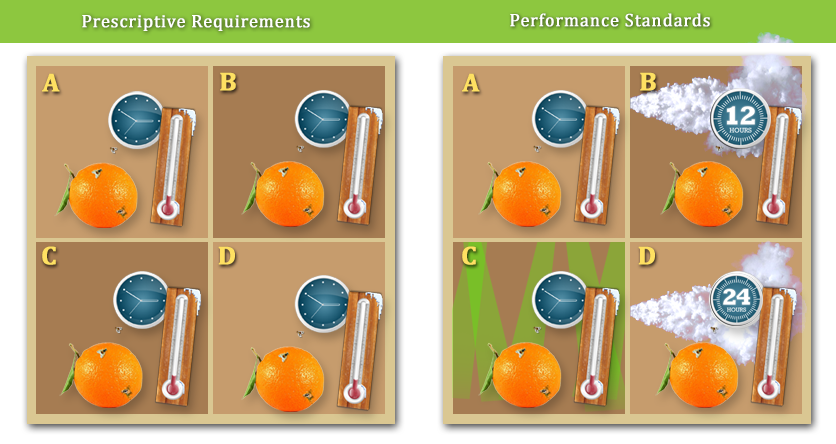Lesson 6: Updating Existing Market Access Requirements
Topic 3: Performance Standards vs. Prescriptive Requirements
In this topic, you’ll learn about the difference between prescriptive requirements and performance standards, and how performance standards can help ensure that market access requirements can adapt to changing conditions.
Objectives:
- Compare and contrast performance standards and prescriptive requirements
- Write a performance standard to use in place of a prescriptive requirement. The performance standard will express a sanitary or phytosanitary requirement in terms of an outcome, rather than in terms of a specific prescriptive requirement or set of requirements. The performance standard should be flexible enough to allow different processes to be used to achieve the desired outcome.
The way a sanitary or phytosanitary measure is described in the regulations can make it easier or harder to change a requirement later. Regulators often draw a contrast between prescriptive requirements and performance standards. A prescriptive requirement spells out everything the regulated party has to do in order to comply with the regulations. A performance standard states the desired outcome and gives the regulated party flexibility to choose a means to achieve that outcome. The idea behind performance standards can be summarized by the following quote from U.S. Army General George Patton:
“Never tell people how to do things. Tell them what to do and they will surprise you with their ingenuity.”
The classic example comes from outside the agricultural realm. An environmental agency can require that power plants install certain technology to reduce particulate emissions, or it can require that particulate emissions be reduced to a certain level and allow power plants to use whatever technology they want to achieve that goal. Using performance standards allows regulated parties to innovate and come up with new solutions to meet agreed-upon goals without having to change the regulations to accommodate those solutions.
APHIS seeks opportunities to use performance standards when establishing new requirements and when revising existing regulations. In a proposed rule published in 2002, APHIS proposed standards for permanent privately owned horse quarantine facilities. One of the proposed requirements was that floor surfaces have drains of at least 8 inches in diameter. APHIS withdrew the proposal and re-proposed it in 2006. One change APHIS made in response to comments was instead to require that floor surfaces have adequate drainage rather than to specify a drain size. APHIS agreed that such a performance standard would give more flexibility to facility designers than a prescriptive requirement for drains 8 inches in diameter. In fact, such a requirement would not necessarily provide for adequate drainage if the 8-inch drains were not properly placed. Thus, performance standards can make the regulations both more flexible and more effective.
Another example comes from phytosanitary treatments. In the past, APHIS listed specific treatment schedules in the regulations. For example, citrus would have to be cold treated for Medfly in accordance with a particular treatment schedule. However, as new treatment options become available, it would be time consuming to update the regulations to add the new treatments. Rather, APHIS regulations now refer to treating citrus fruit for Medfly in accordance with 7 CFR part 305, the phytosanitary treatments regulations. The treatment regulations, in turn, allow for the use of any treatment for Medfly in citrus that has been approved as effective. Approved treatments are listed in the Plant Protection and Quarantine Treatment Manual.

treatment that has been determined to be effective, if a country requests it and any other necessary requirements for performing the treatment are fulfilled.
In other places, APHIS regulations are structured to eliminate the need for rulemaking. The regulations in 9 CFR 94.9 provide conditions for the importation of pork and pork products from areas where classical swine fever (CSF) is known to exist. However, the regulations in § 94.24 recognize the European Union (EU) as a region that is of low risk for CSF, and they prohibit the importation of pork and pork products from any area in the EU where CSF has been detected until the EU recognizes the area as free of CSF or until 6 months following depopulation of any affected swine, whichever is greater. Before, APHIS had published rules to update the list of CSF-affected regions to include countries within the EU whenever a CSF outbreak would occur there, and APHIS had published more rules to remove those regions when the EU eradicated the disease. Now, when CSF outbreaks occur, APHIS simply prohibits importation in accordance with § 94.24 without needing to go through rulemaking, and imports automatically resume according to the schedule in the regulations.
In the past, most requirements in the regulations were prescriptive. However, given the rate of change in the circumstances described in the first topic in this lesson, APHIS seeks to use performance standards wherever possible.
In this topic, you learned about the difference between prescriptive requirements and performance standards, and how performance standards can help ensure that market access requirements can adapt to changing conditions.
To continue, select Topic 4 from the Topics menu above or click here.